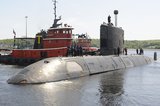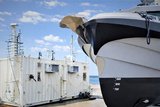USGC transfers cutter to Vietnam
The US Coast Guard (USCG) has transferred the decommissioned Hamilton class high endurance cutter WHEC 722 to the Vietnam Coast Guard, the USCG announced on 26 May.
This marks the eighth cutter transfer through the USCG’s Office of International Acquisition’s Excess Defense Articles programme and the first to another nation’s coast guard. The 378ft ship will be the largest in the Vietnamese Coast Guard’s fleet.
Before the cutter leaves for Da Nang, Vietnam, the Office of International Acquisition is supporting the vessel's maintenance, upgrade and training period in Honolulu. The USCG is providing $13.9 million worth of transfer support, including equipment procurement and installation.
Each high endurance cutter transfer helps the USCG avoid approximately $12 million in disposal costs, in addition to helping build and sustain global maritime partnerships in support of the service’s national maritime strategy.
The WHEC 722, which entered service in March 1969, was decommissioned in April 2017. Three high endurance cutters have been transferred by the USCG to the Philippine Navy and two each to the Bangladeshi and Nigerian navies. Four cutters in the class remain in service in the Pacific.
The high endurance cutters are being replaced by the incoming National Security Cutters (NSC), six of which are already in service.
More from Naval Warfare
-
![Is the US Navy’s Golden Fleet initiative achievable?]()
Is the US Navy’s Golden Fleet initiative achievable?
The effort to provide the US Navy with Trump-class battleships might face financial, production and doctrinal obstacles.
-
![How will SAFE shape naval procurement for Canada and its highest-receiving members?]()
How will SAFE shape naval procurement for Canada and its highest-receiving members?
Canada’s inclusion on the EU’s Security Action for Europe initiative is set to enhance the country’s defence procurement strategy with important implications for some of its naval programmes, while Poland and Romania have also secured significant SAFE funding.
-
![Thales wins DE&S contract for portable autonomous command centres]()
Thales wins DE&S contract for portable autonomous command centres
The agreement to provide portable autonomous command centres to the UK Royal Navy will enhance the service’s Mine Counter Measure operations and further integrate autonomous and uncrewed systems into its fleet.
-
![Maritime defence in the Mediterranean faces challenges from vulnerable land power]()
Maritime defence in the Mediterranean faces challenges from vulnerable land power
As an indispensable energy crossroads, the Mediterranean is at serious risk from grey zone disruption. As navies increasingly employ AI data centres, what happens when cutting-edge defence technologies rely on the very infrastructure most susceptible to hybrid tactics?























